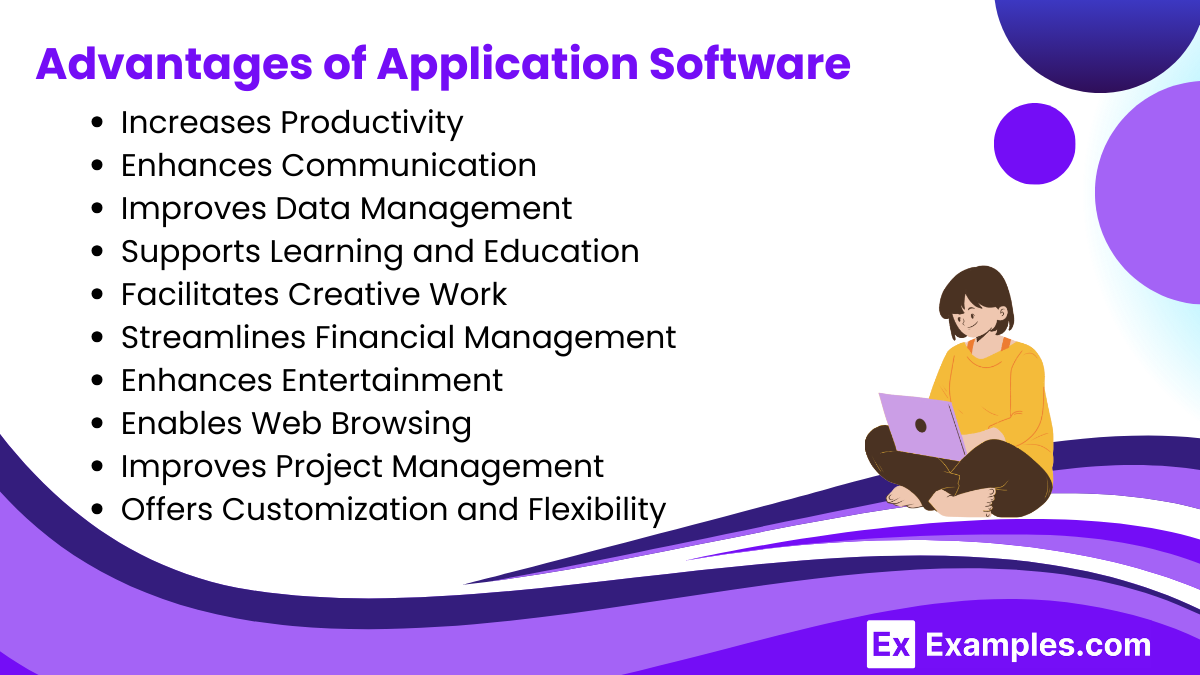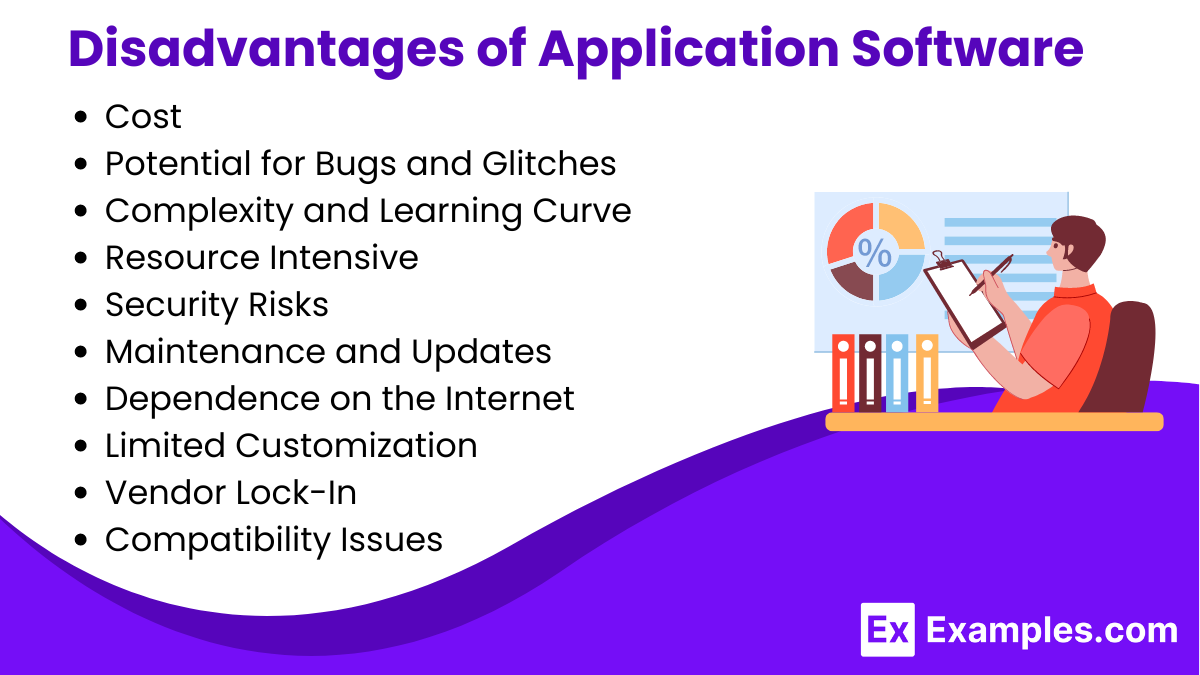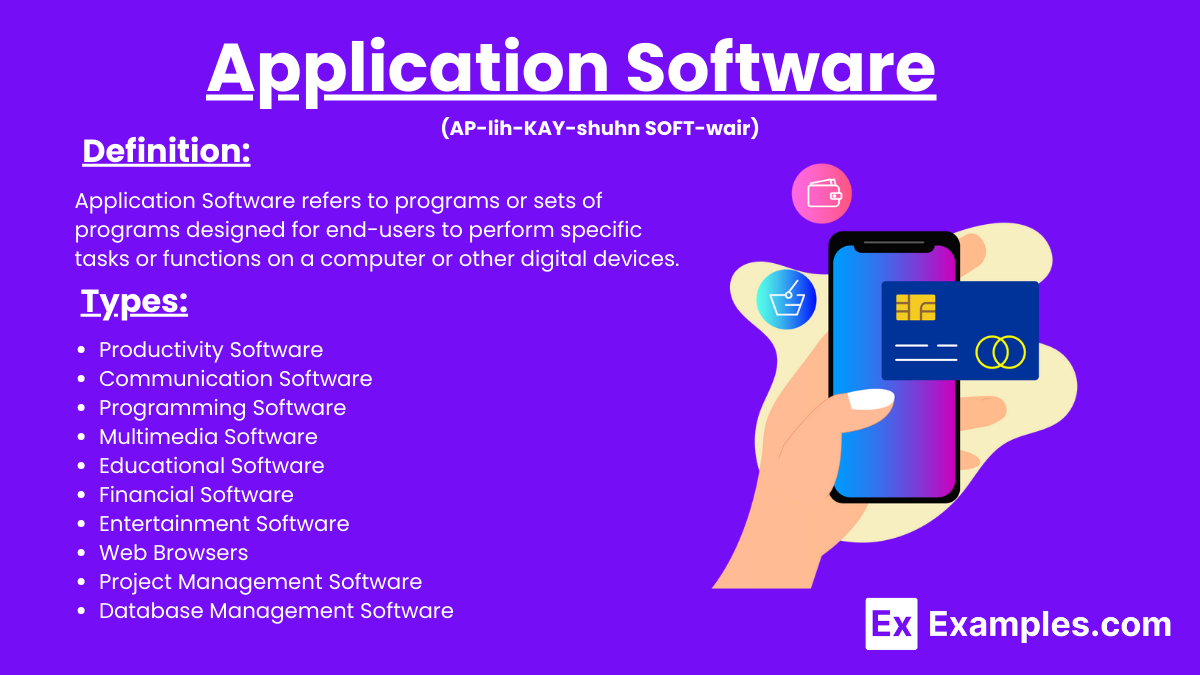10 Application Software Examples
Application Software refers to programs or sets of programs designed for end-users to perform specific tasks or functions on a computer or other digital devices. Unlike system software, which runs the computer itself, application software allows users to achieve particular objectives, such as creating documents, managing data, playing games, or browsing the internet. When initiating a new software project proposal, it’s essential to conduct an application inventory to understand the current software landscape and identify any gaps or areas for improvement.
What is Application Software?
Application Software refers to programs or sets of programs designed for end-users to perform specific tasks or functions on a computer or other digital devices. Unlike system software, which runs the computer itself, application software allows users to achieve particular objectives, such as creating documents, managing data, playing games, or browsing the internet.
Application Software refers to programs or sets of programs designed for end-users to perform specific tasks or functions on a computer or other digital devices. Unlike system software, which runs the computer itself, application software allows users to achieve particular objectives, such as creating documents, managing data, playing games, or browsing the internet. Maintaining an Application Inventory aids in managing and tracking the various software applications used within an organization. When applying for positions like Software Engineer or Software Tester, crafting a compelling Job Application that highlights relevant skills and experiences is essential. Including a Statement Letter for Job Application. Job Application for Software Engineer and Job Application for Software Tester can provide additional insights into qualifications and career goals. Job Application for Freshers often emphasizes educational background, internships, and projects to showcase potential. Prior to initiating new software projects, conducting a Software Gap Analysis can identify areas for improvement or innovation. A well-structured Software Project Proposal outlines objectives, scope, and deliverables, guiding project execution. Following up with a Reminder Email for Job Application can demonstrate professionalism and keen interest in the position.
Examples of Application Software
- Microsoft Word
- Adobe Photoshop
- Google Chrome
- Slack
- Zoom
- Spotify
- Microsoft Excel
- QuickBooks
- AutoCAD
- Dropbox
- Mozilla Firefox
- Skype
- Trello
- Adobe Illustrator
- VLC Media Player
Need for Application Software
- Enhancing Productivity: Application software provides tools that streamline and automate various tasks, significantly enhancing productivity. Programs like Microsoft Office Suite (Word, Excel, PowerPoint) and Google Workspace (Docs, Sheets, Slides) help users create documents, manage data, and prepare presentations efficiently.
- Facilitating Communication: Communication software such as Zoom, Microsoft Teams, and Slack is essential for facilitating real-time communication and collaboration. These tools enable video conferencing, instant messaging, and file sharing, which are crucial for remote work and global connectivity.
- Data Management and Analysis: With the exponential growth of data, there is a critical need for software that can organize, analyze, and interpret data. Applications like Microsoft Excel, Google Sheets, and database management systems (e.g., MySQL) provide robust functionalities for managing and analyzing large datasets.
- Supporting Education and Learning: Educational software such as Duolingo, Khan Academy, and Coursera offers interactive courses, tutorials, and assessments that support learning and skill acquisition. These programs make education accessible and personalized, catering to diverse learning needs.
- Creating and Editing Multimedia Content: Multimedia software like Adobe Photoshop, Adobe Premiere Pro, and Audacity is necessary for creating and editing digital content. These applications offer powerful tools for producing high-quality images, videos, and a, essential for professional and personal projects.
- Financial Management: Managing finances effectively requires specialized software. Applications like QuickBooks, Mint, and personal finance apps help users track expenses, budget, and manage investments, providing insights that aid in financial planning and decision-making.
- Entertainment and Leisure: Entertainment software such as Spotify, Netflix, and Steam provides access to music, movies, TV shows, and video games. These applications cater to the need for entertainment, offering diverse content and interactive experiences.
- Web Browsing and Internet Access: Web browsers like Google Chrome, Mozilla Firefox, and Microsoft Edge are crucial for accessing and navigating the internet. These applications enable users to browse websites, download content, and interact with online services.
- Project Management: Efficient project management is facilitated by software such as Trello, Asana, and Microsoft Project. These tools help plan, organize, and manage projects, enabling teams to track progress, meet deadlines, and collaborate effectively.
- Improving Accuracy and Efficiency: Application software reduces the likelihood of human error and increases the accuracy and efficiency of various tasks. For example, accounting software ensures precise financial calculations, while design software enables precise editing and creation of digital content.
Types of Application Software
Productivity Software: These applications help users produce information, manage projects, and enhance efficiency.
- Word Processors: Used for creating, editing, and formatting text documents.
- Examples: Microsoft Word, Google Docs
- Spreadsheets: Used for organizing, analyzing, and storing data in tabular form.
- Examples: Microsoft Excel, Google Sheets
- Presentation Software: Used for creating visual presentations.
- Examples: Microsoft PowerPoint, Google Slides
Communication Software: These applications facilitate communication between individuals or groups.
- Email Clients: Used for sending and receiving emails.
- Examples: Microsoft Outlook, Gmail
- Messaging Apps: Used for instant messaging and chat.
- Examples: WhatsApp, Slack
- Video Conferencing Tools: Used for virtual meetings and video calls.
- Examples: Zoom, Microsoft Teams
Multimedia Software: These applications are used for creating, editing, and playing multimedia content.
- Photo and Image Editing: Used for editing images and creating graphics.
- Examples: Adobe Photoshop, GIMP
- Video Editing: Used for editing video clips and creating movies.
- Examples: Adobe Premiere Pro, Final Cut Pro
- Audio Editing: Used for editing sound files and creating a content.
- Examples: Audacity, GarageBand
- Media Players: Used for playing a and video files.
- Examples: VLC Media Player, Windows Media Player
Educational Software: These applications are designed for teaching and learning purposes.
- E-Learning Platforms: Used for online courses and learning materials.
- Examples: Coursera, Khan Academy
- Language Learning Apps: Used for learning new languages interactively.
- Examples: Duolingo, Rosetta Stone
Financial Software: These applications assist with financial management and transactions.
- Accounting Software: Used for managing financial records and transactions.
- Examples: QuickBooks, Xero
- Personal Finance Apps: Used for budgeting and managing personal finances.
- Examples: Mint, YNAB (You Need A Budget)
Entertainment Software: These applications provide entertainment through various forms of digital content.
- Streaming Services: Used for watching movies, TV shows, and listening to music.
- Examples: Netflix, Spotify
- Video Games: Used for interactive gaming experiences.
- Examples: Steam, Epic Games Store
Web Browsers: These applications enable users to access and navigate the internet.
- Google Chrome: A fast, widely used web browser.
- Mozilla Firefox: An open-source web browser known for its flexibility and security features.
Project Management Software: These applications help plan, organize, and manage projects.
- Trello: A visual tool for organizing tasks and projects.
- Asana: A project management tool that helps teams track their work.
Database Management Software: These applications are used for creating, managing, and manipulating databases.
- Microsoft Access: A database management tool for small to medium-sized projects.
- MySQL: An open-source relational database management system.
Business Application Software
Business application software refers to programs and tools designed to help businesses perform essential functions, streamline operations, and enhance productivity. These applications cover a wide range of activities, including accounting, customer relationship management (CRM), enterprise resource planning (ERP), and project management. Software gap analysis is often conducted to identify areas where current business software falls short and to determine the necessary enhancements or new solutions required to meet business needs.
Difference between System Software and Application Software
| Feature | System Software | Application Software |
|---|---|---|
| Purpose | Manages and controls hardware and basic system operations | Performs specific tasks for the user |
| Examples | Operating systems, device drivers, utility programs | Word processors, web browsers, media players |
| Interaction with Hardware | Directly interacts with and controls hardware components | Uses system software to interact with hardware |
| User Interface | Often minimal or no user interface | Typically has a graphical user interface for user interaction |
| Dependency | Required for running and managing application software | Depends on system software to function |
| Installation | Comes pre-installed with the computer or is installed during setup | Installed by the user based on their needs |
| Complexity | Generally more complex, involving lower-level operations | Generally simpler, focused on specific user tasks |
| Examples of Tasks | Managing memory, processing tasks, handling system calls | Creating documents, browsing the internet, playing music |
| Update Frequency | Less frequent, often tied to system updates or upgrades | More frequent, with regular updates for new features and bug fixes |
| Performance Impact | Critical for overall system performance and stability | Affects performance only when the application is running |
Advantages of Application Software

- Increases Productivity: Application software provides tools that streamline and automate various tasks, significantly enhancing productivity. Programs like word processors, spreadsheets, and presentation software enable users to efficiently create and manage documents, data, and presentations.
- Enhances Communication: Communication applications such as email clients, messaging apps, and video conferencing tools facilitate real-time communication and collaboration, which is crucial for personal, academic, and business interactions.
- Improves Data Management: Software applications like database management systems and spreadsheets allow users to organize, analyze, and interpret data effectively. This capability is essential for decision-making and strategic planning in businesses and other organizations.
- Supports Learning and Education: Educational software and e-learning platforms provide interactive and engaging learning experiences. These applications offer tutorials, courses, and assessments that cater to different learning styles and needs, making education more accessible and personalized.
- Facilitates Creative Work: Multimedia software for photo editing, video production, and graphic design enables users to create high-quality digital content. These tools support creativity and innovation in various fields, from marketing to entertainment.
- Streamlines Financial Management: Financial software helps individuals and businesses manage their finances by tracking expenses, creating budgets, and generating financial reports. This assists in maintaining financial health and making informed financial decisions.
- Enhances Entertainment: Entertainment software, including streaming services and video games, provides users with a wide range of leisure activities. These applications offer access to movies, music, TV shows, and interactive games, enhancing the entertainment experience.
- Enables Web Browsing: Web browsers allow users to access and navigate the internet efficiently. These applications support various online activities, from searching for information to conducting online transactions.
- Improves Project Management: Project management software helps teams plan, organize, and manage projects. These tools enable task assignment, progress tracking, deadline management, and collaboration, ensuring projects are completed on time and within budget.
- Offers Customization and Flexibility: Many application software programs offer customizable features and settings, allowing users to tailor the software to their specific needs and preferences. This flexibility enhances user satisfaction and productivity.
Disadvantages of Application Software

- Cost: Many high-quality application software programs come with significant costs. Licensing fees, subscription charges, and periodic updates can be expensive, particularly for businesses or educational institutions requiring multiple licenses.
- Compatibility Issues: Application software may not be compatible with all systems or devices. Users may face difficulties if the software is not compatible with their operating system, hardware, or other software applications, leading to performance issues or the need for additional purchases.
- Complexity and Learning Curve: Some application software can be complex and require significant time to learn and master. This complexity can lead to a steep learning curve, necessitating training or professional assistance, which can be costly and time-consuming.
- Resource Intensive: Many applications require substantial system resources, such as RAM, processing power, and storage space. This can slow down or even crash less powerful systems, affecting overall performance and productivity.
- Security Risks: Application software can be vulnerable to security threats such as malware, hacking, and data breaches. Users must regularly update software and implement security measures, which can be cumbersome and require technical knowledge.
- Maintenance and Updates: Regular maintenance and updates are necessary to keep application software running smoothly and securely. These updates can be disruptive, requiring downtime and potentially leading to compatibility issues with other software.
- Dependence on the Internet: Many modern application software solutions, especially cloud-based ones, require a stable internet connection. This dependence can be problematic in areas with unreliable internet access, leading to disruptions in work and productivity.
- Limited Customization: Some application software offers limited customization options, restricting users from tailoring the software to meet their specific needs and preferences. This can result in a less efficient or user-friendly experience.
- Vendor Lock-In: Users of certain application software may become dependent on a specific vendor’s ecosystem. This can lead to difficulties in switching to alternative software due to data compatibility issues, high switching costs, or lack of comparable features.
- Potential for Bugs and Glitches: All software is prone to bugs and glitches, which can disrupt workflows and lead to data loss or corruption. Even with regular updates, new bugs can be introduced, requiring ongoing troubleshooting and support.
What are some common types of application software?
Common types include word processors, spreadsheets, web browsers, email clients, and media players.
How do you install application software?
You can install application software by downloading it from the internet or using installation media like CDs or USB drives.
What is the purpose of application software?
Application software helps users perform tasks efficiently, such as creating documents, managing data, or communicating.
Can application software run without an operating system?
No, application software requires an operating system to function, as it relies on system resources and services.
What is the difference between desktop and web application software?
Desktop applications run on local computers, while web applications run in web browsers and require internet access.
How do updates affect application software?
Updates improve functionality, fix bugs, enhance security, and sometimes add new features to application software.
What is the role of application software in business?
Application software streamlines business operations, enhances productivity, and supports various business functions like accounting, communication, and project management.
Can application software be customized?
Yes, many application software programs offer customization options to meet specific user or business needs.
How do you choose the right application software?
Consider your needs, budget, user-friendliness, compatibility with existing systems, and available support when choosing application software.
What is mobile application software?
Mobile application software, or apps, are programs designed to run on smartphones and tablets, providing various functionalities on-the-go.



